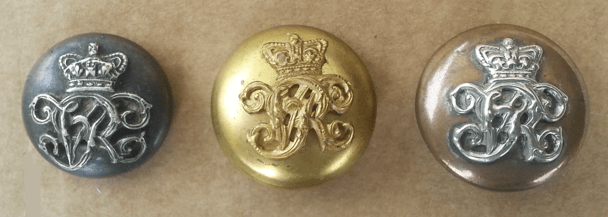Circa 1870 VR Buttons with Escutcheon
I mentioned yesterday that one of the NZ volunteer forces buttons I shared was actually sourced from Australia, although it is of identical design. I now have 3 variations of this types of button.

The button on the left is a smaller and tarnished version of that on the right (copper with silvered escutcheon on a brass base).

All have fixed shanks (the middle one is bent over). The left button is marked Smith & Wright Birmh, the other 2 C.R. Martin Melbourne.
C. R. Martin was a Melbourne based warehouseman/importer of military accoutrements, not a manufacturer. These buttons suggest that Smith & Wright supplied his buttons in this case. In J. K. Cossum’s book ‘Buttons of the Defence Forces in Australia’ this design button is depicted on pages 26 (for Tasmanian Volunteer, Medical & Retired Staff 1870-1901) and on page 29 (for Western Australian Volunteer, Medical & Retired Staff 1870-1901) and according to JSMilitaria was used by some New Zealand Volunteer units from 1866 to 1909, with an example from Smith & Wright depicted on his website.
I don’t think it is a stretch to suggest that Smith & Wright supplied all buttons of this design as a universal uniform button from around 1870. They probably also produced the NSW Military Forces 1870-80 button shown in Cossum on page 5. This varies only in the addition of a banner marked ‘New South Wales’ being added to the bottom of the escutcheon.
(George) Smith & (John) Kemp were manufacturers in Birmingham in 1838 when John Skirrow Wright was employed by the firm. In 1850 he became a partner in what was now called Smith, Kemp & Wright. In 1864 Kemp left the partnership. They continued as Smith & Wright until 1888, then as Smith & Wright Ltd. Although becoming part of the Firmin House Group in the 20th century, this backmark continued to be used during WW1 at least.

Portrait of John Skirrow Wright sourced from Wikipedia.
